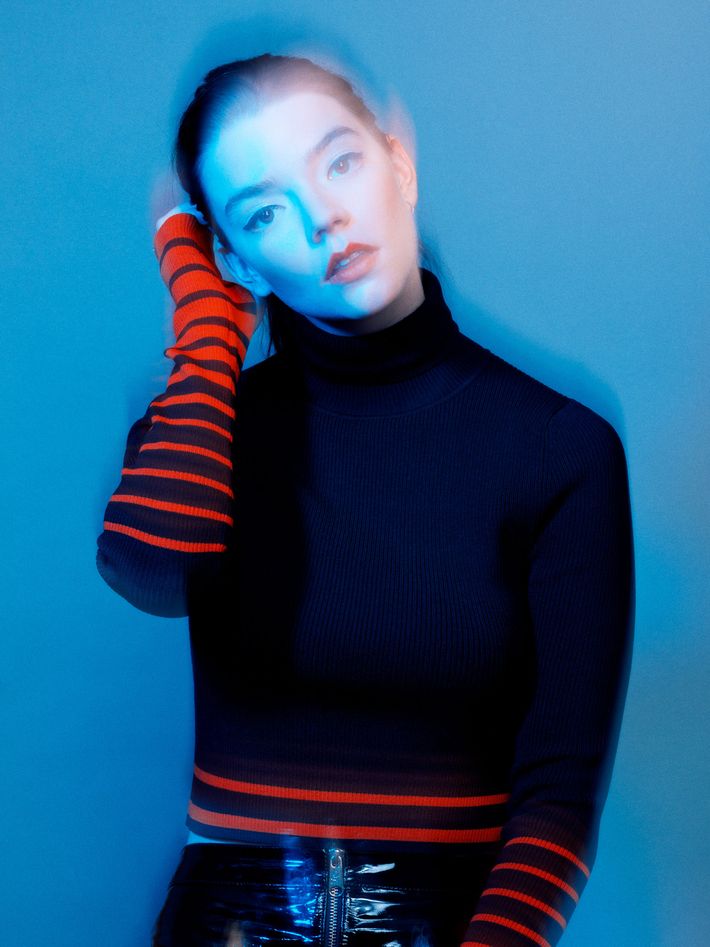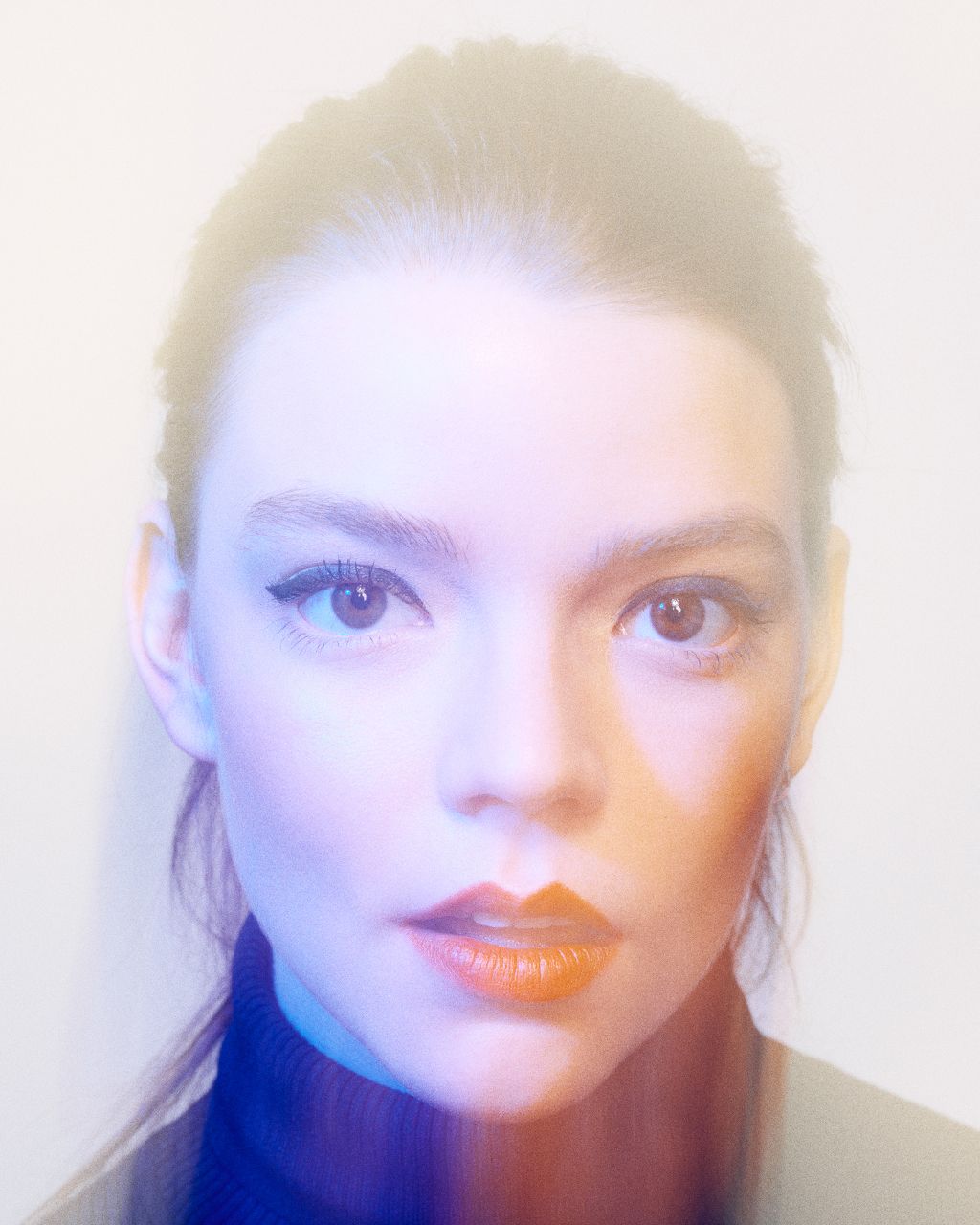One of the first Facebook photos Anya Taylor-Joy was tagged in was a picture of a fish. “I must have been about 10 or 11,” she says. “I was so confused. I went to my parents like, ‘Why? I don’t understand.’ My sister sort of piped up, ‘It’s because your eyes are really far apart. You look like a fish.’ It was the most horrifying feeling – I’m now suddenly aware of something that I can’t ever be unaware of.”
Some stars spend years searching for the thing that will become their trademark. Taylor-Joy got hers from genetics: a pair of large, expressive eyes that have proven incredibly useful for the films in which the 21-year-old actress has made her name. While the first few months of the year are generally considered a cinematic wasteland, they’ve been good for Taylor-Joy. Each winter, she’s starred in a new piece of ambitious genre fare. Whether she’s a “synthetic human” (Morgan), a witchcraft-curious Puritan teen (The Witch), or, most recently, an icy rich girl in Connecticut (the new Thoroughbreds), the camera tends to behold her features with a kind of alien wonder. Directors love isolating her in close-ups, especially in M. Night Shyamalan’s Split, where she spent the entire film gazing in mute horror at James McAvoy’s multitude of accents.
Taylor-Joy doesn’t mind the intense focus on her face, she says over a glass of carrot-ginger juice at a Soho lunch spot. “I don’t give a fuck where the camera is,” she says. “I don’t care what I’m showing, or if I look fat, or if this isn’t a great angle for me.” She has a fair amount of disdain for what she calls “pretty-crying” in movies: “Sometimes I’ll see performances where I’m like, ‘Don’t do that! Be an emotion!’ ” (She also claims she doesn’t like to look in mirrors – “I don’t find it interesting” – which makes her either an incredible liar or the most well-adjusted human on earth.)
Still, there are downsides to not being aware of the camera. The Witch was the first film Taylor-Joy ever starred in, and its initial screening ended with her “hysterically sobbing” when she discovered how much of the movie was just her face. “I thought, Oh my god, my dream’s gone. I can’t act.” It’s worth noting this was not the reaction most viewers had to her performance. “No one came out of the clear blue quite like Anya Taylor-Joy,” Vanity Fair wrote after the movie premiered at Sundance. The New Yorker called her “remarkable,” with a “wide-eyed innocence entwined with a thread of cunning.” The BAFTAs nominated her for the Rising Star Award. The Hollywood Reporter dubbed her the industry’s “next big thing.”
It’s been a quick rise, but Taylor-Joy is accustomed to those kinds of sudden shifts. She spent her childhood in Argentina, the youngest child of a Princeton-educated speedboat racer and a “beautiful, warm-hearted hippie” 20 years his junior. (She was born “on a fluke” during a memorable vacation to Miami, which had the handy side effect of making her a U.S. citizen.) The family emigrated from Argentina during the economic and political turmoil that gripped the country in the early 2000s, settling in the “really nice, very safe” London neighborhood of Knightsbridge. Anya hated it. “Argentina is all green and I had horses and animals everywhere,” she says. “All of a sudden I was in big city and I didn’t speak the language.” (Reading Harry Potter helped with the latter.)
Taylor-Joy has spoken about having felt too English to be Argentinian, and too Argentinian to be English. As an adult, though, she’s largely made peace with her “weird mash-up” of identities. “I find that my sense of humor and the way I conduct myself is British, but with a ton of Argentine warmth,” she says. “I hug everybody. I’m very effusive.”
(She’s not kidding. She is both a hello and a good-bye hugger, and during her short visit to the office, multiple members of the New York staff had what they assumed were perfectly perfunctory interactions with the actress, only to be flummoxed when she attempted to continue the conversation.)
With most of her siblings being decades older, Taylor-Joy was essentially an only child, and even now most of her closest friendships seem to come with directors and crew members. She says she has an “almost roommate-like relationship” with her parents, who let her drop out of school at age 16 to pursue acting. (She wrote them a letter.) As you may be able to tell from the photos that accompany this article, her teenage years also involved a brief stint of modeling. Here, too, there’s a story: She was discovered walking her dog past Harrods, when the head of Storm Model Management pulled up behind her in a black car – a recruiting strategy that does not seem ideal, but worked in this case.

The first audition of Taylor-Joy’s career was for Maleficent, where she went out for the younger version of Angelina Jolie’s character. “When I didn’t get it,” she recalls, “I bawled my eyes out.” Her audition to play Thomasin, the young Puritan girl at the center of The Witch, did not go much better. “I’d been broken up with for the first time the day before and I was an anxious, nervous wreck,” she says. “I didn’t know how to do a Yorkshire accent, and I didn’t know the words. The first thing I said to [director Robert Eggers] was, ‘I’m having a panic attack and I don’t know what I’m doing, but do you still want me to read it?’ And Rob was like, ‘Let’s give it a go.’ And obviously, here we are.”
It went so well, in fact, the character was reconceived to match her personality – less demure, more modern and willful. “Anya seemed like someone who wouldn’t survive well in Puritan society,” Eggers says.
Shyamalan cast Taylor-Joy in Split before The Witch came out; the thriller’s quarter-billion grosses not only rocketed the director back into Hollywood’s good graces, it also proved its star was not just a one-Sundance wonder. (Taylor-Joy recently finished shooting the sequel, Glass.) There is a sense around Taylor-Joy – if not from the actress herself – that things are going to blow up soon, that she could maybe in the not-too-distant future leave the Next Big Thing headlines behind and become a proper movie star. (At the beginning of the interview I tell her I’m counting the times she’s not allowed to answer something; at the end she notes with glee that it only happened once.) Like many young actors, Taylor-Joy says she abhors the thought of careerism. “I’ve never taken a job just to take a job,” she says. “I feel like that would be a bit soul-destroying for me. I read a character and I hear their voice and I feel like I belong to them, and they belong to me.” It’s not quite Method, but it’s close. Her characters, she says, are “real to me. I really defend them and I start to adopt some of their sensibilities.” For Thoroughbreds this proved a particular challenge, as her character Lily, is, by most interpretations, a sociopath. “People on set would be like, ‘God, she’s such a bitch.’ I’d be like, ‘Don’t talk about my character that way!’ ” Only after filming was done could she admit that Lily was “pretty awful and toxic.” But her loyalty runs deep: Saying that aloud, she said, still felt like betraying a friend.
But following her passion has, so far, produced what looks from the outside like a series of savvy career moves. Besides the Split sequel, she’s set to star in a Marie Curie biopic and her first comic-book movie, the X-Men spin-off New Mutants. Taylor-Joy says she’s “of two minds” about the bigger films she’s been working on lately. There’s more money and more time, and both of them mean you don’t have to knock yourself out worrying about one mistake. But she remembers on The Witch, how she once had to help the crew drag a dolly out of the mud, or the time that everyone, even the producers, had to stop what they were doing and pick buds off trees to make it look more like winter. “I like the intensity of having a short amount of time,” she says. “You feel like you’re moving towards the same goal.”
New Mutants was recently pushed back a year for re-shoots – a blessing in disguise, as Taylor-Joy has worked more or less non-stop for the past three years. She has no permanent address, and says she suffers from constant jetlag. Last year, she estimates, she had a grand total of four days off. She hopes the break will allow her to get to a place where she’s “hungry” again; where, she says mock-theatrically, she can feel like “a complete instrument for art!”
In the meantime, she does admit to curating her career in one respect. Taylor-Joy identifies as Latina, but says she’s “very wary” of auditioning for Latina roles. “I’m aware of the fact I don’t look like a typical Latin person, and that’s not fair,” she says. “I don’t want to be someone that you can just sub in for that role when I’m really white and blonde.” Knowing what you look like can be horrifying, but sometimes, it’s a necessary wisdom.



